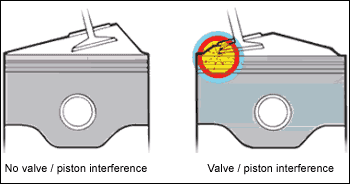Service Tips
TIMING BELT
If you drive a car that's less than ten years old, there is an excellent chance you are driving with a ticking rubber time bomb under the hood. By ignoring this out of sight, out of mind "maintenance-free" component, catastrophic side-of-the-road failure is not a question of "if", but of "when". Most of us are familiar with the rubber belts used to transfer power from the engine to the cooling fan, alternator, power steering pump, and air conditioner. In most cases, these belts can easily be inspected periodically for fraying or excessive wear and are relatively easy to replace. If they do break, you can usually still make it to the repair shop or a telephone. However, many vehicles are equipped with another belt, the engine timing belt, that is not easily viewed.
If neglected, it can cause far more damage than any of the other belts.

Timing belts keep the valves, pistons, and other internal engine parts properly synchronized. The good news about rubber timing belts is that they don't actually stretch, which means there is no need for periodic adjustments. The bad news is that they eventually will weaken and break. The Car Care Council advises that the "cost" of a broken belt can be much more than simply being stranded on the side of the road. Many of today's high-tech engines are manufactured to such extremely close tolerances that a broken timing belt will allow the pistons to hit the valves, bending them and possibly destroying the pistons or even the complete engine as a result.
Timing belts often fail from the inside out, making visual inspection somewhat unreliable. This is why vehicle manufacturers recommend replacement of timing belts, typically every 60,000 - 90,000 miles (or 60 months), although this varies among manufacturers. Timing belt replacement intervals can easily be found in your owner's manual or any garage or dealership service department can look it up for you. Timing belt replacement is a simple procedure for trained technicians. This once-every-four-or-five-years investment is a small price to pay, considering the alternatives, because when it comes to keeping your internal engine parts internal, timing is everything!

